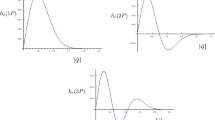Abstract
Motivated by the recent lattice QCD results indicating that the topological charge contribution to the flavor singlet axial vector current can be traded off by the constituent quark masses, we investigate the radiative decays of pseudoscalar (π,K, η, η′), vector (ρ,K*, ω, ϕ) and axial vector (A 1) mesons using a simple relativistic constituent quark model. For both simplicity and relativity, we take advantage of the distinguished features in the light-cone quantization method: (1) the Fock-state expansion of meson wavefunctions are not contaminated by the vacuum fluctuation, (2) the assignment of meson quantum numbers are given by the Melosh transformation. Except the well-known constituent quark masses of (u,d,s) quarks and the spin-averaged meson masses, the only parameter in the model is the gaussian parameter β which determines the broadness (or sharpness) of radial wavefunction. The computed decay widths and the transition form factors of ρ, ω → π(η)γ*,K* →Kγ* andA 1 → πγ* at 0≤Q 2≤5 GeV2 and π0(η) → γ*γ at 0≤Q 2≤3 GeV2 are in a remarkably good agreement with the experimental data and the result forA +1 → π+ γ* transition is quite consistent with the experiments of pion scattering on a nucleus using Primakoff effect. This model is potentially useful in the cocktail analyses of the dilepton productions in proton-proton, proton-nucleus and nucleus-nucleus collisions at SPS energies and a little above.
Similar content being viewed by others
References
W. Cassing, W. Ehehalt and C.M. Ko,Phys. Lett. B363 (1995) 35; G.Q. Li, C.M. Ko and G.E. Brown,Phys. Rev. Lett. 75 (1995) 4007.
C.-R. Ji and S.R. Cotanch,Phys. Rev. D41 (1990) 2319.
C.-R. Ji, P.L. Chung, and S.R. Cotanch,Phys. Rev. D45 (1992) 4214.
G.P. Lepage, S.J. Brodsky, T. Huang and P. Mackenzie, inParticles and Fields 2, eds. A.Z. Capri and A.N. Kamal, Plenum, New York, 1983, p. 83.
C.-R. Ji and Y. Surya,Phys. Rev. D46 (1992) 3565.
C.-R. Ji, in:DIRKFEST’92, eds. W. Buck, K. Maung and B. Serot, World Scientific Publishing, Singapore, 1992, pp. 147–163; C.-R. Ji, Challenges in Light-cone Field Quantization, inSecond Pacific Winter School for Theoretical Physics, Sorak, 1995.
C.-R. Ji, G.-H. Kim and D.-P. Min,Phys. Rev. D51 (1995) 879.
C.-R. Ji, Light-cone field theory and QCD phenomenology, inNuclear and Particle Physics on the Light Cone, World Scientific, NJ, 1989, pp. 291–308; C.-R. Ji, Quark structure of meson, nucleon and deuteron,Revista Mexicana de Fisica, Vol.40, Suplemento1 (1994) 330.
S.J. Brodsky, G. McCartor, H.-C. Pauli and S. Pinsky, The challenge of light-cone quantization of gauge field theory, Tech. Report SLAC-PUB-5811, Stanford Linear Accelerator Center, Stanford University, Stanford, USA, 1992.
K. Hornbostel,Phys. Rev. D45 (1992) 3781; C.-R. Ji, The Lightcone Vacuum,Proceedings of the Cornelius Lanczos International Centernary Conference, published by Siam, 1994, pp. 615–617.
S.J. Brodsky and H.-C. Pauli, inRecent Aspects of Quantum Fields, eds. H. Mitter and H. Gausterer, Lecture Notes in Physics, Vol.396, Springer Verlag, Berlin, 1991.
H. Leutwyler and J. Stern,Annals of Phys. 112 (1978) 94; B.D. Keister and W.N. Polyzou, inAdvances in Nucl. Phys., eds. J.W. Negele and E. Vogt, Plenum, New York, 1991, Vol. 20, 225.
C.-R. Ji,Phys. Lett. 167B (1986) 16; C.-R. Ji and R.J. Furnstahl,Phys. Lett. 167B (1986) 11; C.-R. Ji,Phys. Lett. B322 (1994) 389.
H.J. Melosh,Phys. Rev. D9 (1974) 1095; L.A. Kondratyuk and M.V. Terentyev,Sov. J. Nucl. Phys. 31 (1983) 561.
C.-R. Ji and S.-J. Rey,Phys. Rev. D53 (1996) 5815.
R.D. Carlitz, J.C. Collins and A.H. Mueller,Phys. Lett. B214 (1988) 229.
E. Smith,Phys. Lett. B305 (1993) 344.
Y. Kuramashi et al.,Phys. Rev. Lett. 72 (1994) 3448.
C. Hayne and N. Isgur,Phys. Rev. D25 (1982) 1944.
D.E. Soper, Ph.D. Thesis, SLAC Report No.137 (1971).
Z. Dziembowski,Phys. Rev. D37 (1988) 768;D37 (1988) 778;D37 (1988) 2030.
H.M. Choi and C.-R. Ji, in preparation.
Particle Data Group,Phys. Rev. D50 (1994) 1173.
M. Zielinski et al.,Phys. Rev. Lett. 52, (1984) 1195.
M. Zielinski,Phys. Rev. Lett. 58 (1987) 2002.
Author information
Authors and Affiliations
Rights and permissions
About this article
Cite this article
Ji, C.R., Choi, H.M. Radiative decays and transition form factors of strange mesons in the relativistic constituent quark model. APH N.S., Heavy Ion Physics 4, 369–379 (1996). https://doi.org/10.1007/BF03155633
Received:
Issue Date:
DOI: https://doi.org/10.1007/BF03155633




